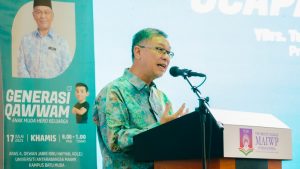This letter is specifically for those who are willing to open their minds and hearts to facts, who are obsessed with truth (in the sense of loyalty) and not with a party.
First, let me emphasize that this letter has nothing to do with the nature of envy or jealousy toward the charity and philanthropic work of a sincere party. What is intended to be implied, however, relates to phenomena that occur because of common factors and trends that are repeated many times in different places and institutions.
In short, I criticize all parties that slip into this phenomenon. We see in recent times that our society in general is very concerned about the welfare and well-being of the weak and less fortunate. This is a very commendable attitude. This also coincides with the Qur’an’s injunction to us to always strive to do good and virtuous things.
However, one side that is often overlooked by a few who are passionate about charity work is the ethical side of taking photos or videos of aid recipients. Likewise, there is sometimes exploitation and manipulation of society’s generosity and philanthropy by a handful of special interest groups and the irresponsible.
In this respect, my letter is actually indirectly meant to make us think and reflect when we are in the skin of the donation recipient. After all, donation recipients are also human beings, who just like donors and donor advocates, have the instinct, dignity, and conscience to change the conditions of their lives.
I am almost certain they have never dreamed of being in that condition. It’s just that they are less fortunate or affected by the inequality or decay of the system. In general, we see the tendency of some parties to portray poverty with touching and heart breaking images that have the potential to stir the emotions and instincts of viewers and the like.
Worse, we see studies that show that the phenomenon of poverty is staged like an opera stage, with filming done through what is called “photo-op” or through what is called ‘voluntourism,’ which consists of traveling abroad while doing volunteer work.
In short, this phenomenon is about exploiting the limitedness of the poor. The modus operandi of this phenomenon is usually carried out by organizations or companies (under the guise of NGOs or charitable foundations), but in reality it is profit-driven, carrying out programs such as corporate social responsibility with the aim of running a business or positioning their brand.
Even more surprisingly, in 2012, Al-Jazeera uncovered and reported how these voluntourism activities contribute to the rising rate of child exploitation in Cambodia.
Moreover, this phenomenon is also common among politicians and state leaders. There is a story that in 1964 the US President Lyndon Johnson paid a visit to a chronically ill land tenant named William David Marlow to promote the Presidential Initiative to Eradicate Poverty. I attach a summary of the report criticizing this:
Marlow lived with his seven children, wife and mother-in-law. A World War II veteran, he suffered from a chronic back injury and earned less than $1,500 a year. To illustrate the family’s living conditions to visiting journalists and politicians, the Marlows were instructed to hang a load of laundry on the clothesline and leave their children barefoot. After the visit, the family struggled with the stigma of poverty. Mrs. Marlow, who had never considered herself poor, later wrote to the president, “We just found out we are the joke of a whole nation.” The 15-minute visit was essentially a photo op to kick off Johnson’s tour of Appalachia.
The fact is, after the visit and the shooting, the poverty level is going back to the old notch and the gap between rich and poor in the US is widening.
So, as I said, try to think for a moment and imagine if we were in the shoes of the recipients or the poor, let alone if pictures of their children were photographed and so circulated in the media.
Or have we ever considered that when they are adults, and it is possible that their condition has changed, but their pictures when they were children, in a state of disarray, with matted hair and tattered clothes, holding hands or holding placards asking for donations, are still there and circulating in the media – if we were in their situation, how would we feel?
An Egyptian writer Abdul Rahman Dahi also alluded to this phenomenon in an article from Al-Jazeera:
“With the advent of social media, every charity makes documentations (image recordings) about their charity work, they also use different ways to promote it. This method has a great impact on gaining the pleasure of their supporters while maintaining their popularity and progress among other institutions. However, they should preserve the human values in every way including taking care of the emotional and psychological aspects of the recipient before preserving the material aspects (donations) as it is feared that (if the psychological aspects are not preserved) it may cause harm or negative impact on the soul of the recipient during his life.”
He also quoted an interpretation of Imam al-Tabari who states in relation to the prohibition of insulting or hurting the recipient in al-Quran chapter 2 verse 263:
“Good words and also a series of prayers for fellow Muslims. It includes covering (or maintaining) their poverty and bad situation. All this is better in the sight of Allah than almsgiving, which is accompanied by painful deeds that also hurt the heart and feelings.”
So, according to the understanding of this verse, anything that can hurt or potentially hurt the recipient is prohibited, including the potential to hurt or offend the recipient’s feelings by showing pictures or video footage that may not be approved of and may even affect his dignity.
Let us try to go back to the time before the existence of the camera lens, what was it actually like? If we think logically and with common sense, we can naturally conclude that the donor will donate directly without worrying about which photo is best and most perfect, or even risking that the captured image will violate the dignity of the recipient.
So, this shows the relevance of the values found in the Quran, which cover all aspects and also survive the times, whether before or after the existence of the camera lens.
Muhammad Furqan Abdullah
Zakat Officer, PPZ-MAIWP








